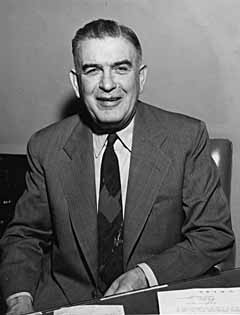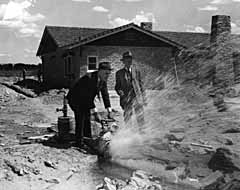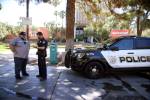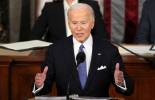Ernie Cragin




More than anything else, Mayor Ernie Cragin wanted a Las Vegas that would be a good place to live. He wanted Las Vegans to enjoy stable jobs that paid well, paved, clean streets, parks and swimming pools.
But his failure to include black people undercut his dream. Neglecting the needs and rights of a growing minority generated social problems that have plagued Las Vegas ever since.
With Cragin at the helm, Las Vegas became a serious, well governed city.
On Cragin’s watch, Las Vegas went Jim Crow.
Cragin was born in 1895 in Wyoming but moved to Las Vegas in 1911. His father was a storekeeper with the San Pedro, Los Angeles & Salt Lake Railroad, which was Las Vegas’ key industry at the time. Cragin attended business school in Los Angeles and got his first job as a stenographer for the railroad. He also had a part-time job working at the Majestic Theater, and by 1915 was operating the Airdome open-air theater at Third and Fremont streets.
The precocious Cragin was an insurance salesman by 1914, when he was only 19, and bought out the agency operated by Peter Buol, Las Vegas’ first mayor. In 1916 he took in a partner, William Pike.
Cragin & Pike remains an important insurance agency; the partners also invested in real estate and in buying the Majestic.
Cragin joined the Navy in 1917 and was assigned to the submarine service. He would be active in veterans affairs the rest of his life. That October, he married the pretty girl who sold tickets at his theater, Lucille Marleau. Their only child, Marleau Ernest Cragin, would be born in 1920.
His business skills drew him into government, first as deputy county recorder in 1922 and then as a court reporter under Judges William Orr and Roger Foley. In 1922 he became a director of a new company organized to conduct a grocery business; Harley A. Harmon, the county clerk who was about to become district attorney, was its president.
In 1928, he and Pike would open El Portal, which would become Las Vegas’ most important movie theater and at times its only one.
“It was a fine theater,” remembered Harley E. Harmon, who as a boy worked at a competing movie house. “It had a loge section, which meant it had big, comfortable leather chairs, and you paid extra to sit there.”
Cragin’s investments were blessed with the business boom brought by the construction of Hoover Dam. His political aspirations were blessed by the arrest of Mayor Fred Hesse for violating Prohibition and Hesse’s subsequent decision not to run for re-election. In 1931, Cragin ran for the office.
The Las Vegas Age did not endorse anybody in the race. This may have been because its owner, C.P. “Pop” Squires was a diehard Republican and Cragin, though city offices were supposed to be nonpartisan, was becoming closely identified with top Democrats.
Al Cahlan, editor of the Las Vegas Evening Review-Journal, had no such reservations. He had brought his newspaper out of obscurity to overtake the more established Age in a few short years, and he had not done it by being afraid to take stands. Cragin’s announcement and every statement he made were reported exhaustively in Cahlan’s paper. His opponent, Lou Hansell, was an experienced city commissioner, yet his announcement got only a 3-inch story at the bottom of the page, and the Review-Journal managed to make the headline about Cragin instead of Hansell. It said, “CRAGIN TO HAVE AN OPPONENT IN MAYORALITY RACE.”
Cahlan even hinted in his personal column that sinister forces — whom he did not name — were opposed to Cragin’s election.
To nobody’s surprise, Cragin won in a landslide.
Smarting from the publicity Las Vegas had received as a wide-open construction boomtown where sex and even liquor were openly sold, he urged Las Vegans to be selective in the kind of businesses they allowed to feed off the boom. “We should … guard against those who prey upon our citizenry; they have no investment; they are here today and gone tomorrow.
“We should let the world know Las Vegas is a good place to live in; that we bear a good reputation and that our city is free from the grafters and is not the stench hole we have been painted.”
Cragin pressed businessmen to pave the dirt between their property lines and the street, giving Las Vegas sidewalks even in quarters where the city itself couldn’t yet afford to build them. He wanted businesses to accept delivery of goods only at back doors, so streets wouldn’t be blocked. He called for raising the speed limit to a realistic 20 mph, then enforcing it. He wanted parking banned from 1 a.m. to 6 a.m. so streets could be swept, and parking in alleys banned altogether, for fire safety.
In mid-1932 Cragin fired the police chief, Clay H. Williams, for running a department which wrote too many traffic tickets for petty offenses and left too many visitors determined not to come back.
In 1933 he voted to ban keno games, which were regarded as lotteries — and as competition for the nickels and dimes coveted by merchants in the Depression economy. A year later, however, he voted to reopen the game while organizing a public referendum on whether it should be legal.
Paradoxically, the dam boom which brought prosperity to local businesses brought poverty to city government. The population needed civic services and facilities faster than revenues were found to pay for them. Work on a badly needed expansion to the city sewer system began in early 1932, but in 1933 Cragin was forced to cut city salaries, including his own. Some employees were laid off.
However, the election of Franklin D. Roosevelt and his New Deal policies changed this picture. Federal money became available for civic improvements.
“With Senators (Key) Pittman and (Pat) McCarran casting vital swing votes for many New Deal programs, the Roosevelt Administration was particularly responsive to the needs of Las Vegas, Reno, and other Nevada communities,” wrote Eugene P. Moehring in “Resort City in the Sunbelt,” his history of Las Vegas from 1930 to 1970.
Most things accomplished under the New Deal had been part of Cragin’s platform even before Roosevelt was elected. Yet with an enviable track record of promises kept, Cragin was turned out of office partly for fighting still another New Deal project. Councilman Leonard Arnett decided that Southern Nevada Power Company’s rates were too high, and began seeking New Deal funds for a municipal power plant and to bring power to Las Vegas from Hoover Dam. He also began seeking the mayor’s seat occupied by Cragin.
Arnett was able to convince voters that Cragin represented the power company’s interests and not the public’s. He also criticized Cragin for alleged favoritism in awarding New Deal contracts, and even for his close ties with Cahlan. Cahlan resorted to publishing articles asserting that the smart money was betting on Cragin’s re-election. “Mayor E.W. Cragin was installed a favorite in the betting in the mayoralty campaign today with at least one wager at odds approximating 5-3 being offered and untaken in a downtown gambling club.” He didn’t name the club.
In the municipal election of 1935 Arnett beat Cragin 1,472 to 1,093.
After all Arnett’s trouble, the municipal power project never came to pass. Arnett would resign in disgust in 1938.
Cragin threw himself into the Elks Helldorado celebration, a communitywide festival launched in 1935 to attract tourism by saluting Las Vegas’ Western heritage. Strangely, in a town whose actual history was studded with gunfighters and renegade Indians, where aged “single-blanket jackass prospectors” still told stories for drinks and companionship, the Elks rented costumes from Hollywood and dressed up everybody to fit the movie stereotypes. Cragin, who normally wore tailor-made business suits, would show up in publicity photos as a tall “cowboy” lifting a “dance hall gal” who was, in mundane fact, his respectable wife.
Meanwhile, Las Vegas’ city administration dissolved into bickering and fiscal crisis. When Cragin offered to take up the reins again in 1943, nobody else filed for the office, and he became mayor by default.
Always at his best when trying to build consensus, Cragin was part of the group that managed to convert the Basic Magnesium complex at Henderson — no longer needed to make magnesium for tracer bullets and flares — to peacetime uses.
Cragin’s administration launched an ambitious program of publicly funded civic improvements such as a new police station, street pavements, and public swimming pools.
But his best bet to pay for the needed improvements went awry in 1946 when he tried to annex the Strip. He argued that the few Strip resorts really fed off the fame of Fremont Street, which was the older and then-bigger casino district. But opponents needed only 50 percent of the affected residents to block the annexation; they got more than 90 percent to oppose it.
In 1950 Gus Greenbaum, the mobster who ran the Flamingo after Bugsy Siegel was assassinated, would lead a campaign to make Paradise Valley, which included the Strip, an unincorporated town. This meant the area could not be annexed without the approval of county commissioners, an event that most expect to happen the same day suckers get an even break.
The failure meant that tax revenues remained limited and expenditures had to be carefully prioritized.
And it was in prioritizing that Cragin’s reputation has suffered the most. By the accounts of black Las Vegans, he didn’t prioritize fairly and his failure to do so made West Las Vegas one of the worst slums in the West.
Whatever problems West Las Vegas retains today, the neighborhood offers gracious living compared to the shantytown that emerged there in the ’30s and ’40s. It wasn’t entirely Cragin’s fault, but Cragin may have been the only person who could have kept it from becoming a ghetto — and he didn’t.
Las Vegas has had a black population almost from its beginning. It has been estimated that 50 blacks lived here as early as 1925, with the adults employed largely as railroad porters, track crewmen, janitors or maids. In a research paper called “The Mississippi of the West,” historian Perry Kaufman found that blacks in those days could go where they liked, except in movie theaters. In Cragin’s El Portal, said Harmon, blacks and the noticeably Hispanic were steered to the left; whites could sit on the right or in the middle. Another theater confined blacks to the balcony.
In the 1930s, Kaufman said, blacks mostly lived interspersed with whites in an eight-block area between First and Fifth streets and from Stewart to Ogden. Beginning in the 1930s, however, this formerly residential area was increasingly devoted to bars, brothels, restaurants. Both blacks and whites began moving away, but blacks, because of limited employment opportunities and consequent lack of money, gravitated to the inexpensive properties of West Las Vegas. Restrictive deed covenants, prohibiting sales or rentals to blacks, meant they couldn’t go to many other neighborhoods even if they could afford them.
The black population exploded during World War II, when many were hired to build and work in the war industry at Henderson. Most came from the Deep South, and were surprised to encounter living conditions worse than any they had previously known. Most were unable to find housing anywhere other than the segregated facilities built in connection with the war plants, or in West Las Vegas. Because few construction materials were available to the private market during wartime, much housing was in tents and makeshift shanties.
In the South, restaurants, bars, and stores often required blacks to use the back door and take all orders “to go,” but in Las Vegas, downtown businesses, particularly the emerging casinos and night clubs, increasingly refused to serve blacks at all. In the 1940s, the city of Las Vegas refused to renew business licenses for black-owned businesses in downtown Las Vegas, unless owners agreed to move to West Las Vegas.
After Cragin’s election in 1943, Las Vegas police actively enforced segregation. Officers closed the Star Bar in West Las Vegas; the Review-Journal reported this was because the “bar has been playing to a mixed trade, with Negroes and whites encouraged to congregate in the establishment promiscuously.”
Lubertha Johnson, who told of her civil rights work in Las Vegas in an oral history published by UNR, said police enforced segregation at Cragin’s theater. “If you insisted on NOT sitting against the wall, the police were called. All the theaters were segregated, but it seems that others didn’t make the effort to see that this policy was carried out like Mr. Cragin did.”
Many soldiers stationed or trained in the Southwest, including the entire military police regiment assigned to protect Boulder Dam from saboteurs, were black, and often visited Las Vegas. Those who had been reared in the North were particularly offended at being denied access to Las Vegas’ already-famous night life. They clashed with police in West Las Vegas in August 1943, and one man on each side was wounded by gunfire. In 1944 rioting and gunfire broke out again; one soldier was killed, three wounded, and one policeman was also slightly wounded. Army and city officials responded by restricting blacks further. One base declared Las Vegas off limits to its black troops.
Partly because of these tensions, the American Federation of Labor constructed a communal facility with showers and laundry tubs for West Las Vegas, and a USO was set up there for black soldiers. But West Las Vegas remained mostly a shantytown without adequate sewers, fire plugs, street lights or pavement on most roads. Appeals to Cragin went unanswered; at least twice he told community leaders that property values there did not justify extending services.
In 1944 city bulldozers leveled 75 shacks which didn’t meet fire or building codes. In 1945 they cleared another 300. But Moehring has pointed out, “While the move pleased health reformers, it only promoted more overcrowding in the Westside, because black residents … had nowhere else to live.”
Cragin’s administration did build a pool in West Las Vegas. It opened in 1947, just a few weeks before one opened on the white side of the railroad tracks. The clear intent was to operate segregated facilities.
Harley E. Harmon thinks Cragin has had more than his share of blame for Jim Crow policies. “They mention him because of what he did in the theater, but you can’t put the blame on just one man. A lot of the casino owners came from the South and it was just normal to them to do it this way.”
But Johnson said Cragin’s anti-black attitude was extreme even for the times. “He talked down to us as if we were really stupid for thinking we should be treated like anybody else … Most people … like to avoid showing that they are really prejudiced.” But Cragin “conducted himself as if it was really the right thing to do.”
Cragin held on to the mayor’s post until 1951. He was defeated in a re-election bid by C.D. Baker.
Cragin worked every day in the insurance office in the El Portal building. In 1959 he dropped dead at his desk of a heart attack. He was 64.
However much blame Cragin must take for the social injustices he tolerated, Kerestesi says “He was a compassionate and open-minded man; I never heard him speak ill of anybody.”
And whatever he may have done wrong, Kerestesi points out that Cragin did most things right. Once Cragin pointed out the former Las Vegas High School, at Seventh and Bridger. “He said he was instrumental in securing that location and was criticized because it was so far out of town.
“He visualized the growth of Las Vegas way back when most people couldn’t see it, and he was one of the people who actively kept it growing,” said Frank Kerestesi, a partner in Cragin & Pike.
Part I: The Early Years
Part II: Resort Rising
Part III: A City In Full


















